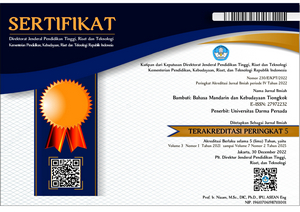THE IDIOMATIC MEANING OF 成语 CHENGYU WHICH HAS NATURAL ELEMENTS
MAKNA IDIOMATIK成语CHÉNGYǓ YANG BERUNSUR ALAM
Abstract
Mandarin is rich in vocabulary, including the form of 成语chéngyǔ, which is one of the most important parts in Mandarin. Every 成语chéngyǔ has its own background story, including history. Therefore, to understand the meaning of 成语chéngyǔ must understand the background of the story from 成语chéngyǔ. This article describes the idiomatic meaning of 成语chéngyǔ which has natural elements contained in the book of 成语故事Chéngyǔ Gùshi. Each Han character (汉字 Hànzì) that becomes an element in成语chéngyǔ does not reflect the overall meaning of the forming element, so that in general the成语chéngyǔ has idiomatic meaning. The method used in this writing is qualitative descriptive. There are 21成语chéngyǔ with natural elements in the book of 成语故事 Chéngyǔ Gùshi, however only one 成语chéngyǔ which contains partial idiom meanings, the other 20 of 成语chéngyǔ contains the full idiom meaning because of the forming elements do not reflect the idiomatic meaning. 成语chéngyǔ has a syntactic function in the sentence, as well as functions as advice, satire, and also praise to people indirectly.

This work is licensed under a Lisensi Creative Commons Atribusi 4.0 Internasional.
Authors who publish with this journal agree to the following terms:
- Authors retain copyright and grant the journal right of first publication with the work simultaneously licensed under a Lisensi Creative Commons Atribusi 4.0 Internasional that allows others to share the work with an acknowledgment of the work's authorship and initial publication in this journal.
- Authors are able to enter into separate, additional contractual arrangements for the non-exclusive distribution of the journal's published version of the work (e.g., post it to an institutional repository or publish it in a book), with an acknowledgment of its initial publication in this journal.
- Authors are permitted and encouraged to post their work online (e.g., in institutional repositories or on their website) prior to and during the submission process, as it can lead to productive exchanges, as well as earlier and greater citation of published work (See The Effect of Open Access).









